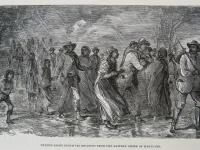The Historical Society of Pennsylvania has received a grant from the National Endowment for the Humanities to support the planning phase of a digital history project about the Underground Railroad. The project will tell this extraordinary story through the personal accounts of the enslaved men and women who passed through Philadelphia between 1852 and 1857. The project will digitally link the manuscript journal and published book of William Still, known as the “Father of the Underground Railroad.”
As chairman of Philadelphia’s Vigilance Committee, Still recorded the personal accounts of those who either passed through or who stayed in Philadelphia and sought the committee’s services. Still’s compelling documentation—in the form of his Journal C and his Vigilance Committee account books—of the names, ages, physical descriptions, treatment, motivations, skills, and the details of the physical and emotional journeys provide rich content for discussion about slavery and escape. This journal is held in trust by HSP on behalf of the Pennsylvania Abolition Society. Twenty years after he began work for the Vigilance Committee, William Still published The Underground Rail Road. This book constitutes the single most extensive contemporary compendium of the operation of the Underground Railroad in one vast region and of the hundreds of individuals who served it.
The first phase of this project will plan and create a prototype for a curated and interactive website that will weave together transcripts and digital facsimiles of documents through links to biographies, extensive historical research and other contextual annotation and materials, as well as to maps that allow users to visualize both the paths of flight and the networks of people who sustained and used this covert organization. In addition, HSP will use this planning phase to work with a team of scholars and advisors to tease out the primary storylines/interpretive lenses that will guide the project and user experience. With Still’s resources interpreted and linked for the first time, scholars, educators, students, genealogists, and history enthusiasts will be able to make deep connections both geographically and chronologically as they are guided through his meticulous documentation.
Any views, findings, conclusions, or recommendations expressed in this project do not necessarily reflect those of the National Endowment for the Humanities.


